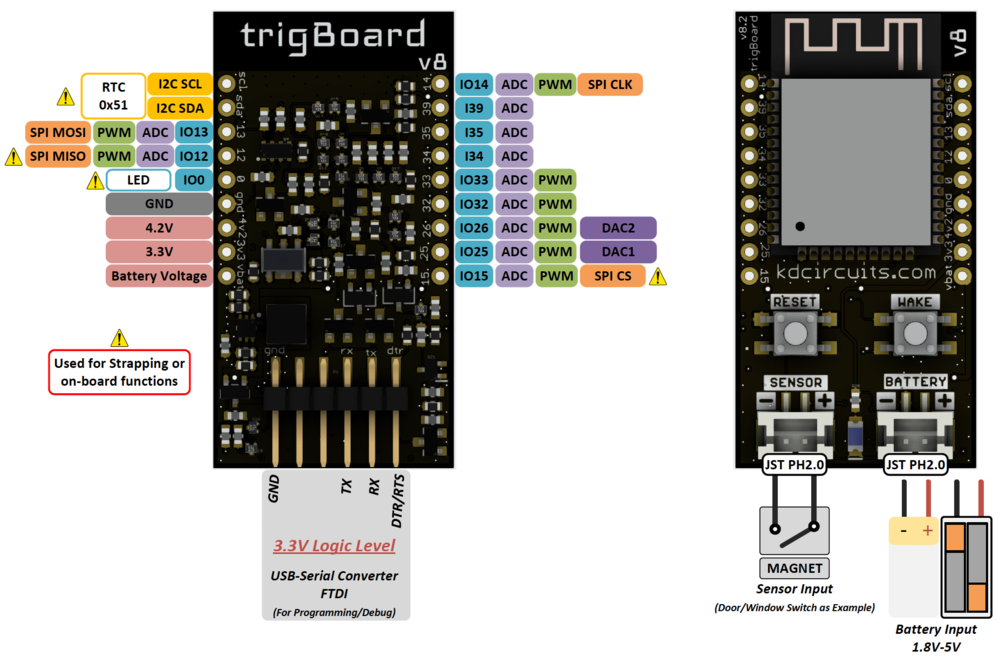Difference between revisions of "TrigBoardV7"
| Line 32: | Line 32: | ||
# '''Hardware Setup''' - All that's needed here is a battery and a dry contact used for triggering. Both connectors on the board are standard JST PH 2.0mm | # '''Hardware Setup''' - All that's needed here is a battery and a dry contact used for triggering. Both connectors on the board are standard JST PH 2.0mm | ||
#* '''Battery Selection''' A good capacity for the trigBoard is 500-1000mAh, but this depends on how often the board will be triggered. Any of these Lithium batteries would work from [https://www.adafruit.com/category/574 Adafruit]. Or two AA or AAA batteries would work, with a holder like [https://www.adafruit.com/product/4191 this] | #* '''Battery Selection''' A good capacity for the trigBoard is 500-1000mAh, but this depends on how often the board will be triggered. Any of these Lithium batteries would work from [https://www.adafruit.com/category/574 Adafruit]. Or two AA or AAA batteries would work, with a holder like [https://www.adafruit.com/product/4191 this] | ||
| − | |||
#* '''Sensor''' These door sensors from [https://www.amazon.com/gp/product/B00LYD3Y6Y/ref=ppx_yo_dt_b_asin_title_o02_s01?ie=UTF8&psc=1 Amazon] work really nice, especially since they can be wired to directly. This allows for any wire length that is needed. The PH2.0 cable can also be found on Amazon like [https://www.amazon.com/gp/product/B07Q39Z7SS/ref=ppx_yo_dt_b_asin_title_o02_s00?ie=UTF8&psc=1 these] if it has to be a little longer. Note that the polarity of the sensor input does not matter. | #* '''Sensor''' These door sensors from [https://www.amazon.com/gp/product/B00LYD3Y6Y/ref=ppx_yo_dt_b_asin_title_o02_s01?ie=UTF8&psc=1 Amazon] work really nice, especially since they can be wired to directly. This allows for any wire length that is needed. The PH2.0 cable can also be found on Amazon like [https://www.amazon.com/gp/product/B07Q39Z7SS/ref=ppx_yo_dt_b_asin_title_o02_s00?ie=UTF8&psc=1 these] if it has to be a little longer. Note that the polarity of the sensor input does not matter. | ||
Revision as of 17:02, 26 February 2020
...Back to Projects:
The trigBoard is an extremely low power platform for the ESP32 WiFi+Bluetooth Module. This board is perfect for battery powered applications, due to it's single digit uA standby current draw ~1.5uA with a 3V battery input. To give an idea as to how low this current draw is, a cheap smoke detector pulls about 7uA. This board was initially designed to be the ideal IoT device - a WiFi connected battery powered monitoring solution for dry contacts (door/window sensors), where a push notification is immediately sent when the contact state has changed. The ultra low standby current does not change regardless if the contact remains in the closed/opened state (this is part of the secret sauce in the trigBoard design). But of course, the trigBoard is a playground of low power features, so it can easily be adapted to a unique monitoring application:
- Many battery options, with input voltage range from 1.8-5V. Great for two AAA batteries or even a rechargeable Lithium cell at 4.2V. Reverse polarity protection built in, so no issues if batteries are plugged in backwards.
- Multiple wake sources all configurable through software (no solder jumpers)
- Dry contact trigger input supporting BOTH contact OPEN and contact CLOSE, but configurable for either or both, so if for example a garage door was monitored, a push notification could go out for when the garage opens AND when the garage closes.
- The board utilizes an actual RTC (Real Time Clock). This is a high quality RTC, so accurate wake times can be configured. The timer wakes the board up at the configured time - for example once and hour, then checks the battery voltage and if low, will send out a push notification. The timer can also be used to check the current status of the contact and send out a notification, so in the garage door example, the board can be configured to not only send out notifications when the door opens/closes, but also when the garage is left open for some period of time.
- Wake button on board can also be used to send out a push notification.
- Unused pins from ESP32 broken out for future expansion and in-line to fit breadboards - developer friendly.
- Base Firmware supports many Push Notification service options like Pushsafer, Pushover, and IFTTT. And even develop a custom solution with MQTT and UDP messaging. Any of these can be enabled, or even multiple. For example, the notifications can go out through Pushover, then a secondary backup notification can go through MQTT. Or even a notification though Pushsafer, then turn the lights on in the house with IFTTT. The possibilities are endless with this.
- Configuration software gives full control over the board parameters and settings - in a nice clean easy to use GUI through Google Chrome and a Bluetooth connection to the ESP32.
Latest Release Version 8
Purchase trigBoard
v8 to be ready soon...
Out of the Box Setup
The trigBoard v8 ships preloaded with base firmware, so it's very easy to get up and running.
- Hardware Setup - All that's needed here is a battery and a dry contact used for triggering. Both connectors on the board are standard JST PH 2.0mm
- Battery Selection A good capacity for the trigBoard is 500-1000mAh, but this depends on how often the board will be triggered. Any of these Lithium batteries would work from Adafruit. Or two AA or AAA batteries would work, with a holder like this
- Sensor These door sensors from Amazon work really nice, especially since they can be wired to directly. This allows for any wire length that is needed. The PH2.0 cable can also be found on Amazon like these if it has to be a little longer. Note that the polarity of the sensor input does not matter.

